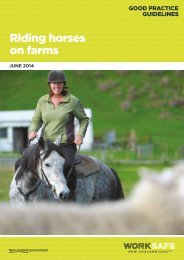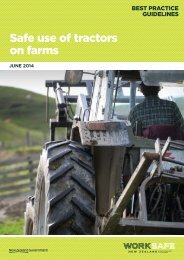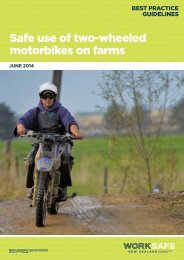PERFORMANCE
our-performance-story-2015
our-performance-story-2015
Create successful ePaper yourself
Turn your PDF publications into a flip-book with our unique Google optimized e-Paper software.
OUR <strong>PERFORMANCE</strong> STORY 2015<br />
31<br />
EMPLOYEES PARTICIPATING IN<br />
HEALTH AND SAFETY AT WORK<br />
Workplaces are likely to be safer when workers<br />
know how to keep themselves and their colleagues<br />
safe and can actively participate in health and<br />
safety arrangements at their work. In 2014/15<br />
we began to develop a worker participation<br />
implementation strategy in support of the new<br />
Health and Safety at Work Act. Formal systems of<br />
employee participation are required by the Health<br />
and Safety in Employment Act 1992 (the HSE Act)<br />
in large workplaces, and in small workplaces if<br />
requested by staff. In the 2014/15 National Survey<br />
of Employers, 48% of employers reported that<br />
their businesses had formal systems for employee<br />
participation, similar to the 2013/14 result and<br />
slightly lower than in 2012/13. Informal employee<br />
participation is also important. Around half of the<br />
respondents to both the 2014/15 Health and Safety<br />
Attitudes and Behaviours Survey and the National<br />
Survey of Employers indicated that health and<br />
safety was discussed at regular team meetings<br />
at their work.<br />
“ New Zealand needs to empower<br />
workers within their workplaces<br />
with rights, training, and support.<br />
No official can be there all of the<br />
time but workers are capable of<br />
being the safety leaders<br />
if they are supported.”<br />
Helen Kelly, President of the<br />
New Zealand Council of Trade<br />
Unions, in the July/August 2015<br />
Safeguard magazine.<br />
Employers and workers were asked in the Health<br />
and Safety Attitudes and Behaviours Survey how<br />
often they would discuss things that put health<br />
and safety at risk (eg near misses or accidents) in<br />
an open and helpful way. Employers were more<br />
optimistic, with 52% saying always, whereas 41%<br />
of workers said they always discussed these risks.<br />
We seek increases in 2015/16, supported by the<br />
new Act.<br />
STRENGTHENING GOVERNMENT<br />
ACCOUNTABILITY AND<br />
LEADERSHIP<br />
We have been engaging with public sector<br />
agencies to support government leadership on<br />
workplace health and safety. This will help agencies<br />
to be prepared to implement the health and<br />
safety reforms and have appropriate support. We<br />
have prioritised agencies according to risk, giving<br />
intensive support to agencies whose activities are<br />
predominantly high risk (eg emergency services).<br />
We have also been working with public sector<br />
chief executives and their leadership teams on the<br />
roles that they will need to play in implementing<br />
the health and safety reforms. Discussions have<br />
started with the State Services Commission,<br />
MBIE, New Zealand Security Intelligence Service,<br />
New Zealand Defence Force, New Zealand Police,<br />
and New Zealand Public Service Association.<br />
Information is being shared about how agencies<br />
can manage risk without compromising their<br />
service obligations, and manage overlapping<br />
responsibilities.<br />
IMPROVED CO-ORDINATION<br />
BETWEEN AGENCIES: BETTER<br />
COVERAGE AND REDUCING<br />
DUPLICATION<br />
WorkSafe is one of several agencies operating<br />
in the health and safety system. Other primary<br />
agencies are: MBIE; ACC, which has a joint interest<br />
in injury prevention and functions and programmes







